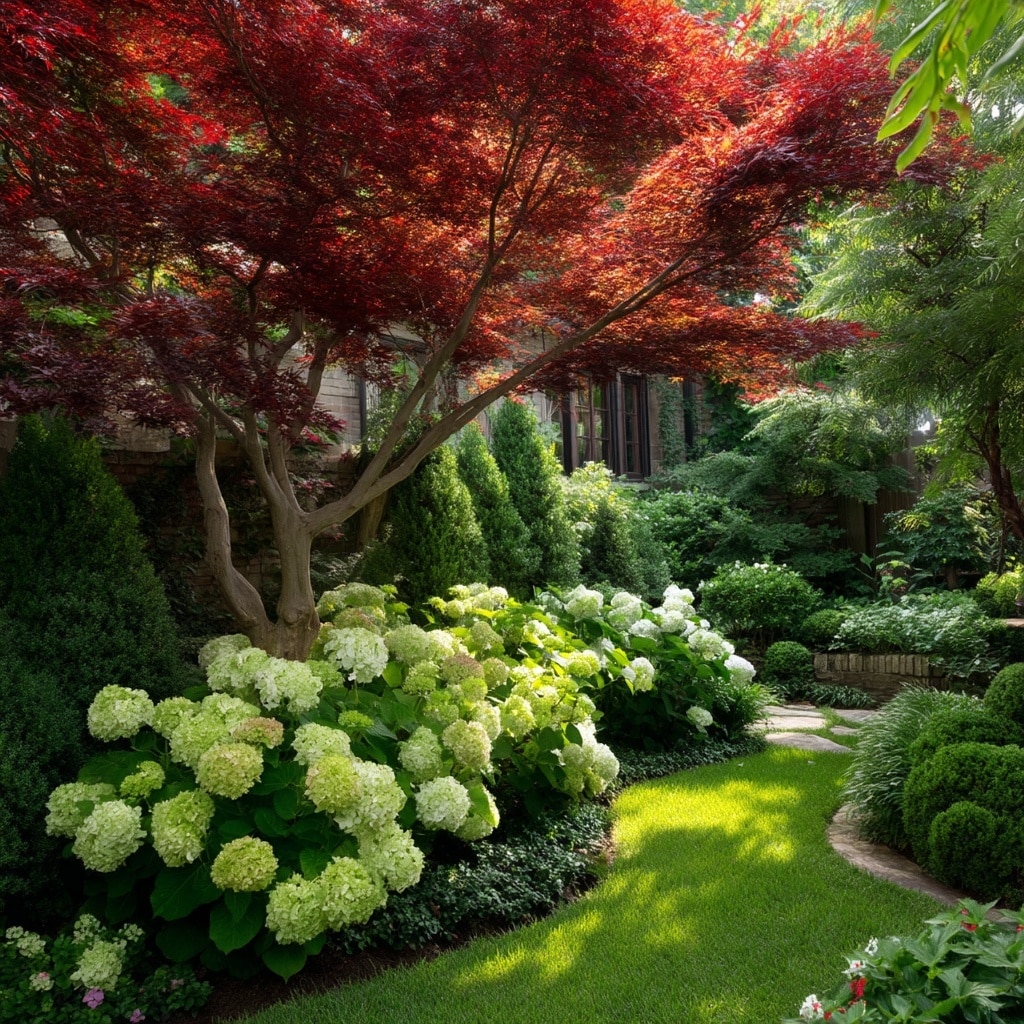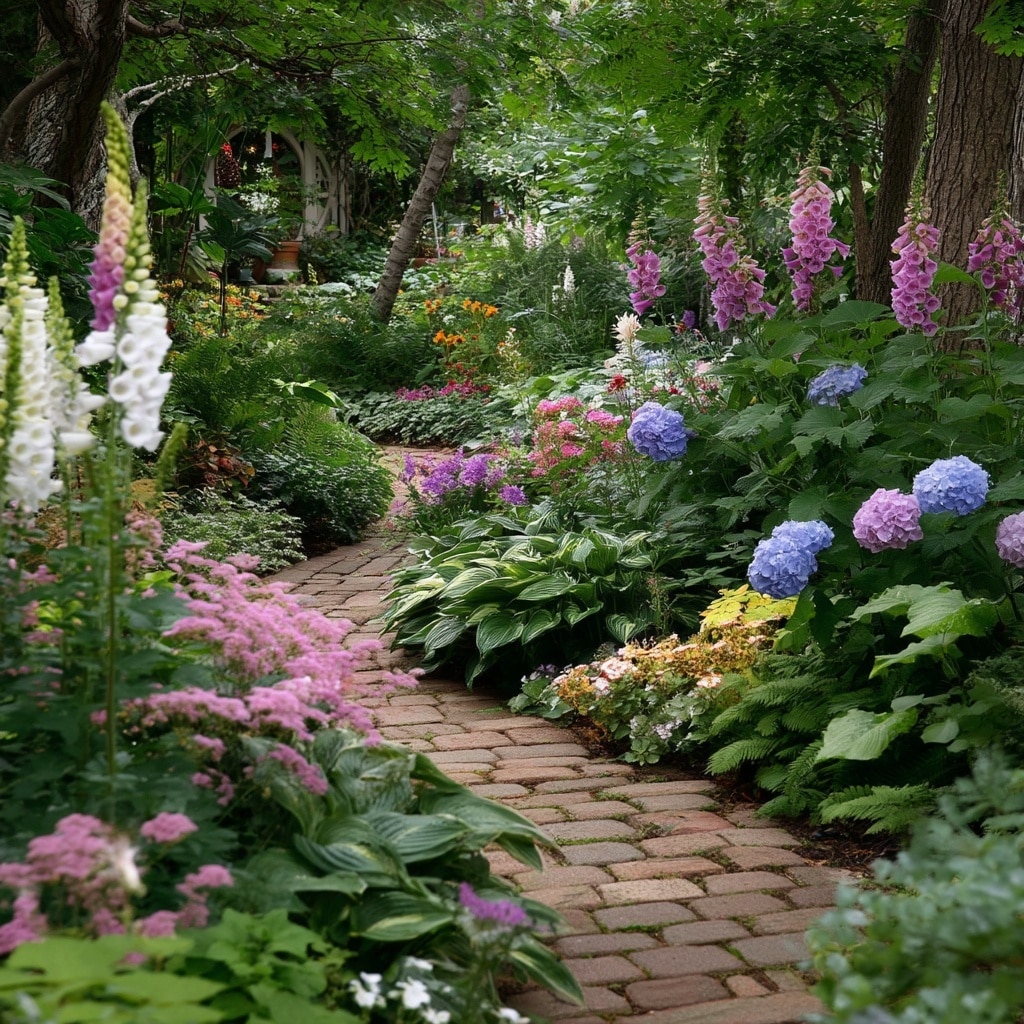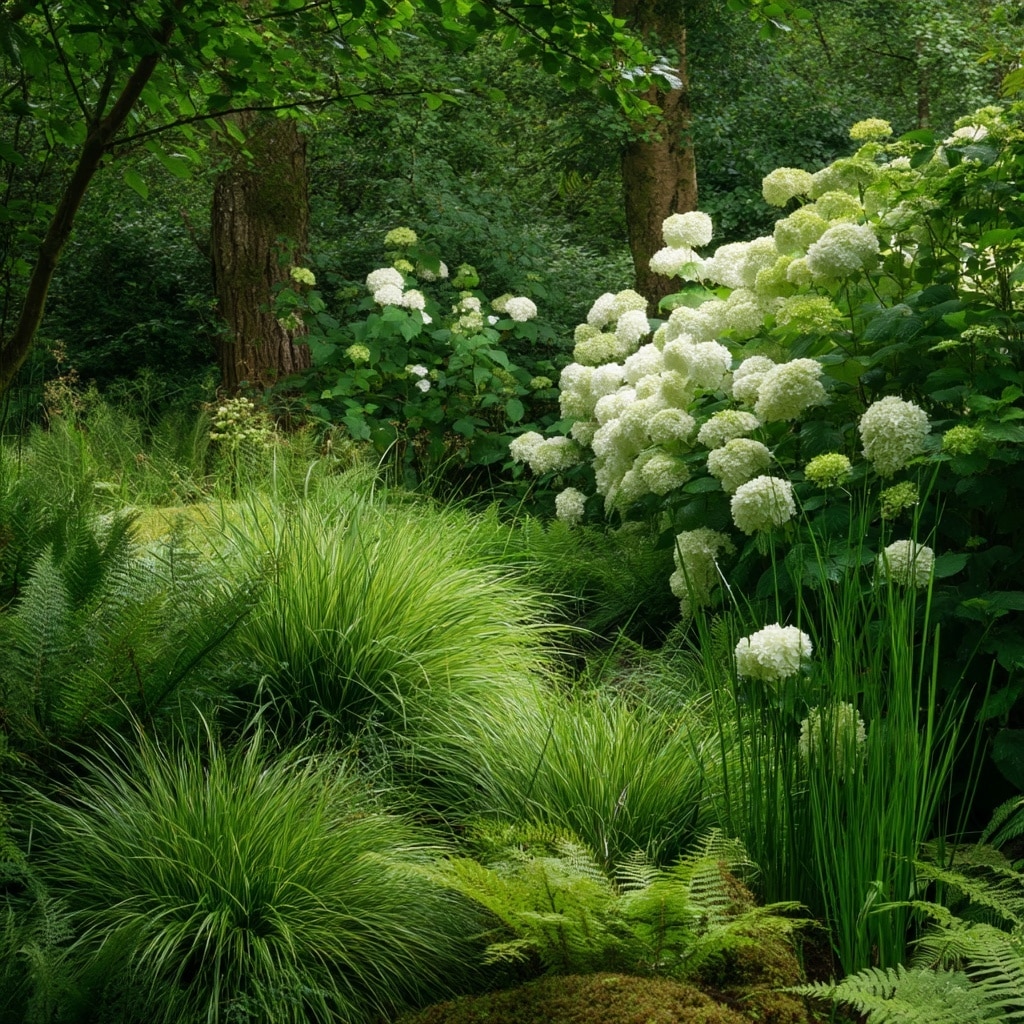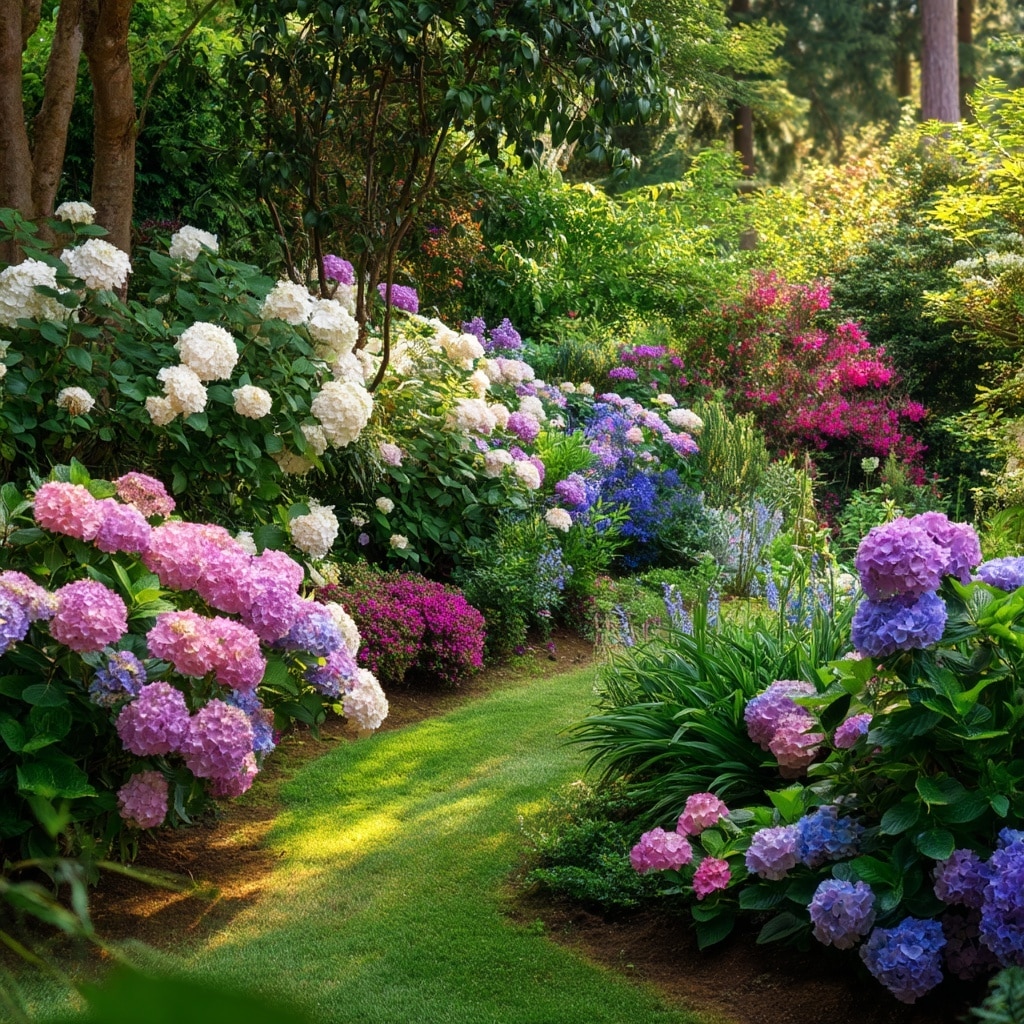Hydrangea shrubs are the stars of many gardens, known for their massive, colorful blooms and rich green foliage. But even the most spectacular plant benefits from the right supporting cast. By choosing the right companion plants, you can enhance the beauty of your hydrangea, extend your garden’s blooming season, and create a balanced, visually appealing landscape.
The key is to pair hydrangea with plants that thrive in similar conditions — partial shade, moist soil, and moderate climates — while also complementing its texture, height, and flower form. Whether you’re aiming for a classic cottage garden or a more natural woodland look, these 15 companion plants will bring out the best in your hydrangeas.
Table of Contents
How to Choose the Right Companion Plants for Hydrangea
Not all plants are suited to share space with a hydrangea. While this flowering shrub is adaptable, choosing the right companions requires matching both growing conditions and aesthetic appeal. Here’s what to keep in mind:
Match Growing Conditions
- Light: Most hydrangeas prefer partial shade or dappled sun. Choose plants that tolerate or prefer the same.
- Soil: Hydrangeas thrive in moist, well-drained, slightly acidic to neutral soil. Acid-loving plants will often be great companions.
- Moisture: Hydrangeas need regular watering. Avoid pairing them with drought-tolerant plants that prefer dry roots.
- Growth habit: Hydrangeas grow fast and can spread wide. Companion plants should be vigorous but not aggressive, and able to hold their own without competing.
Complement Their Look
- Color coordination: Choose foliage and bloom colors that contrast or harmonize with your hydrangea’s flowers. Soft tones like pink and blue pair beautifully with greens, purples, and whites.
- Bloom time: Combine plants that flower before or after hydrangeas to extend the season of visual interest.
- Shape & texture: Mix forms — hydrangeas are typically round and full. Pair them with vertical, feathery, or trailing plants for balance.
These principles will guide you as we dive into specific shrub, tree, perennial, grass, and fern companions that work wonderfully alongside hydrangeas.
Shrubs That Thrive Next to Hydrangeas

Shrubs are a natural match for hydrangeas. They offer similar scale, texture, and structure, creating layered plantings that feel lush and intentional. The following shrubs share compatible growing conditions with hydrangea and add beauty before, during, or after its bloom cycle.
1. Camellia (Camellia spp.)
Camellias are elegant, shade-loving shrubs with glossy green leaves and rose-like blooms that appear from late fall to early spring—perfect for filling in the quiet months before hydrangeas bloom. Their color palette includes whites, soft pinks, and rich reds, which pair beautifully with blue or pink hydrangea varieties.
- Bloom time: Fall through spring
- Light: Partial shade
- Height: 6–10 feet
- Soil: Moist, acidic, well-drained
2. Japanese Andromeda (Pieris japonica ‘Red Head’)
This evergreen shrub complements hydrangeas with its bright red new leaves, delicate drooping white flowers, and compact size. It thrives in the same partially shaded, slightly acidic soil, and offers seasonal interest even when hydrangeas are not blooming.
- Bloom time: Early to mid-spring
- Light: Full sun to partial shade
- Height: 6–8 feet
- Soil: Rich, acidic to neutral, moist, well-drained
3. Azaleas and Rhododendrons (Rhododendron spp.)
These spring bloomers provide massive floral displays in pinks, purples, and whites just before hydrangeas wake up. Choose evergreen varieties for year-round structure and make sure your soil is acidic for both plants to thrive.
- Bloom time: Mid to late spring
- Light: Dappled sun or shade
- Height: 5–12+ feet, depending on variety
- Soil: Moist, acidic, well-drained
4. Butterfly Bush (Buddleia spp.)
Butterfly bush adds late-season blooms when hydrangeas are slowing down. Its long flower spikes in lavender, pink, or purple attract pollinators and provide height and movement to the landscape.
- Bloom time: Mid-summer to fall
- Light: Full sun to partial shade
- Height: 3–10 feet
- Soil: Well-drained, moderately fertile
5. Sweet Fern (Comptonia peregrina)
Though not a true fern, this low-growing native shrub offers finely textured, fragrant foliage and modest flowers in early summer. It complements the fullness of hydrangeas while adding a woodsy feel to garden borders.
- Bloom time: Late spring to early summer
- Light: Full sun to partial shade
- Height: 2–5 feet
- Soil: Well-drained, slightly acidic, sandy or loamy
Small Trees to Pair with Hydrangeas

Small ornamental trees can act as gentle overstory plants for hydrangea, offering filtered shade, visual height, and multi-season interest. These trees enhance the layered look of garden beds and contribute contrasting form and foliage without overshadowing your shrubs.
6. Japanese Maple (Acer palmatum)
Graceful and refined, Japanese maples are a favorite pairing for hydrangeas. Their finely cut leaves create a soft, lacy backdrop, and their brilliant seasonal color changes—from deep reds to golds and purples—bring year-round appeal. These trees also enjoy the same slightly acidic, moist soil conditions.
- Foliage interest: Spring through fall
- Light: Partial shade to dappled sun
- Height: 8–15 feet
- Soil: Moist, rich, well-drained, slightly acidic
7. Lawson Cypress (Chamaecyparis lawsoniana)
If you want evergreen structure, Lawson cypress delivers. Its feathery foliage and vertical form create a textural contrast to the broad, leafy mass of hydrangeas. With blue, green, and even gold-tipped varieties, you can match or contrast your hydrangea’s color palette.
- Foliage interest: Year-round
- Light: Full sun to partial shade
- Height: 5–20 feet, depending on variety
- Soil: Moist, well-drained, neutral to slightly acidic
These compact trees won’t overwhelm your hydrangea shrubs, and they add dimension and structure that lasts beyond the blooming season. Together, they create a harmonious, multi-level planting design that feels natural yet curated.
Perennial Flowers That Pair Beautifully with Hydrangeas

Perennials are the perfect way to bring color, form, and softness to your hydrangea beds. These flowering plants return year after year, and the best varieties will thrive in the same moist, shady-to-part-sun conditions as your hydrangeas. They also help extend the floral season with early or late blooms.
8. Daylily (Hemerocallis spp.)
A garden classic, daylilies offer big, colorful blooms in nearly every shade except blue—making them perfect complements to both blue and pink hydrangea varieties. Their fountain-like foliage adds movement and softness around the base of larger shrubs.
- Bloom time: Early to late summer
- Light: Full sun to partial shade
- Height: 2–4 feet
- Soil: Well-drained, fertile, adaptable
9. Coral Bells (Heuchera spp.)
With striking foliage in hues from deep plum to peach, coral bells are ideal for planting along the front edges of hydrangea beds. While their flower spikes are subtle, it’s their colorful leaves that provide contrast all season long.
- Bloom time: Late spring to early summer
- Light: Partial shade
- Height: 12–18 inches
- Soil: Rich, moist, well-drained
10. Chinese Astilbe (Astilbe chinensis)
With tall, feathery plumes and deep green foliage, astilbe adds elegance to shaded borders. Its upright shape contrasts beautifully with the rounded form of hydrangea, and it loves the same moist conditions.
- Bloom time: Mid to late summer
- Light: Partial shade to full shade
- Height: 3–4 feet
- Soil: Moist, rich, well-drained
11. Foxglove (Digitalis purpurea)
Foxgloves are striking vertical bloomers with bell-shaped flowers that bring drama to hydrangea plantings. Their soft pastels or bold purples work beautifully with hydrangea tones, and their tall spikes create visual balance with round flower heads.
- Bloom time: Early to mid-summer
- Light: Partial shade
- Height: 3–4 feet
- Soil: Moist, slightly acidic, well-drained
12. Hosta (Hosta spp.)
Hostas are unmatched for their bold, textured leaves in blues, greens, and variegated combinations. Perfect for edging under taller hydrangeas, they echo the shrub’s lush feel and fill shady spaces beautifully.
- Bloom time: Mid to late summer
- Light: Partial to full shade
- Height: 1–2 feet
- Soil: Moist, fertile, well-drained
13. Blue Star (Amsonia tabernaemontana)
This underused gem forms soft, billowy mounds with star-shaped sky-blue flowers that bloom in spring and early summer. It offers a light, airy contrast to the dense form of hydrangea and attracts pollinators while adding a cooling hue.
- Bloom time: Late spring, with occasional reblooms
- Light: Full sun to partial shade
- Height: 2–4 feet
- Soil: Moist, well-drained, clay-tolerant
Grasses and Ferns That Enhance Hydrangea Beds

While they may not bloom like perennials or shrubs, grasses and ferns add movement, structure, and rich texture that complements the bold leaves and round blooms of hydrangea. These companions help soften edges, fill gaps, and keep garden beds interesting even when flowers aren’t in bloom.
14. Hakone Grass (Hakonechloa macra)
Also called Japanese forest grass, Hakone grass is prized for its graceful, arching blades that shimmer in the shade. It thrives in the same moist, rich soils that hydrangea loves and comes in gold, green, and variegated varieties that brighten darker corners of your garden.
- Foliage interest: Spring through fall
- Light: Partial to full shade
- Height: 1–2 feet
- Soil: Moist, well-drained, humus-rich
15. Eastern Hay Scented Fern (Dennstaedtia punctilobula)
This native North American fern spreads gently through rhizomes, forming a fragrant, soft-green carpet under shrubs. Its fine texture and low profile make it perfect for planting beneath hydrangeas, especially in woodland or naturalistic gardens.
- Foliage interest: Spring through fall
- Light: Partial to full shade
- Height: 1–2 feet
- Soil: Moist, fertile, slightly acidic to neutral
Together, these grasses and ferns bring depth, texture, and seasonal continuity to hydrangea beds. Their elegant leaves move with the breeze and offer structure when the flowering season fades — adding a professional, layered finish to your garden design.
Conclusion
Pairing the right plants with your hydrangea shrubs transforms a beautiful garden into a breathtaking one. From bold-flowering shrubs and elegant small trees to long-blooming perennials, textured grasses, and shade-loving ferns, these companion plants enhance the natural charm of hydrangeas and support a healthy, balanced planting scheme.
With thoughtful selection, you can enjoy a garden that flows visually, blooms across seasons, and stays vibrant long after the hydrangea’s show is over. Whether you’re building a shady border or designing a lush cottage-style bed, these 15 companion plants will help your hydrangeas shine at their fullest potential.






